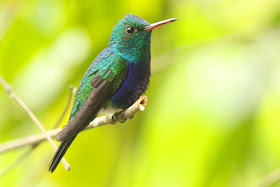While I'm not sure any Central American set-ups can compete with the Fiery-throateds and friends at Paraiso Quetzal in Costa Rica, these didn't disappoint.
White-necked Jacobin were the most common.
Above is a male and a female, below a close-up of a female.
I didn't spend a ton of time with the Jacobins having focused on them pretty extensively at Rancho in Costa Rica.
Much less common was Blue-chested Hummingbird, a fairly understated species that doesn't show much of a gorget from the side or below. I've never seen this (or its sister species Charming) come in to feeders; views had been limited to birds perched fairly high.
However, if you look at it head-on (especially if a little above it) the bright crown comes out. This species used to be known as Beryl-crowned Hummingbird before it and Charming were split.
With the exact right angle the blue (or in this case purplish) upper breast comes out.
Long-billed Hermits were more common
I probably would have taken more pics of these if not for the next bird which was a lifer.
We saw a female Violet-bellied Hummingbird in the morning, but this was my first exposure to the males.
They were very small, probably 2/3 the length and half the bulk of the jacobins.
A female...
One last look at the male













Amazing shots!
ReplyDelete